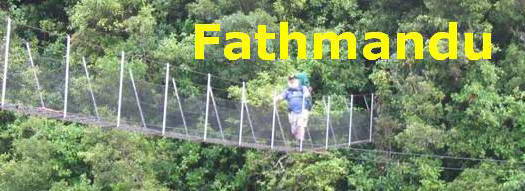|
1 February 2007
Lucy Cranwell Track

Unlike some of the other track names, this one is easy to source. Lucy Cranwell was one of New Zealand's foremost botanists, one of "the two Lucies". You can find out more here.
This track is another you have to walk into. It does not connect with a road. It joins the Marguerite Track to the Kauri Grove Track.

The map is deceptive. There are few if any straight stretches on the track longer than about 25 metres, and while the map readout is 827 metres, ARC notes more accurately, I think, give it as 1 km. On the other hand they describe it as a steep descent. Downhill, yes, but not even remotely in it compared with such as the Incline or Slip Tracks, the Cascade section of the Montana Trail, or even the Home Track.

We are taking things steadily and fatman time for this 30 minute track (ARC notes) is about 10 minutes over the hour, me carrying a full training pack around 19 kg. I think 30 minutes, unless you were fit and agile, might be a bit optimistic. My shoulder is pinging a little from a small injury a few days back, but nevertheless, is not that much of a drag..
I think today proves the track is available to the elderly and stout, but not a great deal more, apart from the fact that the elderly and stout might enjoy it considerably.
We begin this "steep descent" in a relatively gentle fashion

and for a while we maintain this broad, gently sloping passage through fairly open bush - even a dracophyllum or two.
A dry looking fungus attaches to an even drier looking piece of wood.

Up here there is no shortage of tall trees, but a significant gap between them and the next layer down allows a good deal of light in to influence what grows and how.

The edge of the path is bristling with Blechnum fraseri, the miniature tree fern. This fern sometimes looks slightly odd to me as, while the similarity exists between this and a tree fern, the relative proportions of each are importantly different - like a small child playing dressups. The hard, shiny lush, metallic fronds can be most attractive, though, especially in young plants.

I think this might be my favourite pic from this track, well-spotted by Dan's eagle eye; someone has tied a granny knot in a young lancewood:

The track begins to narrow and to throw tree roots at us.

I said of the Marguerite Track that nobody had been along with planks and nails to shore up this and bridge that. Nevertheless, I have always been appreciative of the team that makes regular trips along these tracks with a chainsaw. Crawling on hands and knees or bush crashing to get under or round a fallen trunk is not something I enjoy.

Along the way a little, Dan points out a lancewood (horoeka, Pseudopanax crassifolium) with mature leaves, but which has retained juvenile trunk formation.

I think I've mentioned my dad's boyhood enterprise harvesting lancewood rickers for sale to be turned into fishing rods, valued for their whippy strength and durability. This tree has all the appearance of a "Mr New Zealand Bush" with it's tightly corded muscles rippling under the bark.
There is a yelping from stage right, somewhere in the wings. Alice - and to be fair, she is very good at sticking to the track -has taken a long cut on the last corner, and her lead has become tangled in something deep in the interior. Dan to the rescue on the grounds (his) that his lesser bulk will cause less damage to off the track vegetation.
"Who am I to blow against the wind....?"
Alice is restored to safety, and sticks closely to heel for a goodly period.

We continue on down, through bush that becomes increasingly lush. The gradient is somewhat steeper as well but nothing to daunt and no cause to stumble.

We encounter another lancewood similar to the last.

I know anthropomorphism is wicked and sentimentally Victorian but there's something so very human about the form of this trunk.

We contine downwards. Sometimes when I've been walking for a while, I begin to register "more tracK" and pigeonhole it with all the other stuff I've walked through today, but when I catch this and treat it with a swallow of water, I start seeing it again as new with it's own small population variables. Alice shows a little interest so I unhook the plastic dish from the side of the pack and give her a swallow or two of water as well.

This, I think is some kind of native orchid but I know next to nothing about this plant group

and this is the first time I've ever seen aerial roots on a supplejack - another spotter's brownie point for Dan.

We reach the bottom of thre track and cross the stream. Alice is more interested in how far up and downstream she can go, and whether she can get properly wet.

We head up the track about 50 metres or so

and there's the sign. We've reached Kauri Grove Track.

|

